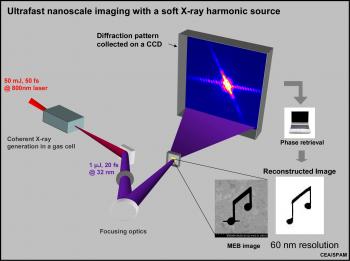|
Thank you to click here and access the new website : Ultrafast Nanophotonics |
Imaging individual objects with few nanometers resolution in space and few femtoseconds resolution in time is of fundamental importance in many areas of science and represents today a fascinating challenge. Advances in coherent x-ray diffraction have demonstrated the very high potential in imaging single non periodic nanometer scale structures [Miao, Nature 400 (1999); Pfeifer et al., Nature 442 (2006)]. Imaging from coherent X-ray diffraction is elegant in its experimental simplicity: a coherent X-ray beam illuminates the object under study and one measures the far-field diffraction pattern on an area detector (proportional to the modulus squared of the Fourier transform of the wave exiting the object). Inverting the diffraction pattern into an image in real space requires retrieving the phases of the diffracted far-field, this being achieved through an iterative algorithm (image retrieved shown at the bottom right in the figure). The lensless imaging has been recently demonstrated – in the single-shot regime [Chapman et al. Nature Phys 461 (2006)], and even in the time-resolved pump-probe scheme [Barty et al. Nature Phys (2008)] – at 13.5 nm on the VUV-FEL FLASH.
These spectacular results validate the concept of ultrafast single-shot diffraction imaging of nanoscale dynamics, in isolated nanoscale materials or biological systems (cell, virus).
Access to ultra-fast dynamics of non repetitive phenomena relevant in major biological, physical or chemical processes requires obtaining single shot diffraction patterns. Up to now, this possibility was limited to intense femtosecond coherent soft X-ray pulses from a free electron laser facility. Laser-driven ultrashort coherent X-ray sources offer a comparatively inexpensive and widely available alternative. However their brightness has so far restricted their application to static phenomena, where signals can be accumulated over millions of shots [Sandberg et al., PNAS 105 (2008)]. Our group overcomes this bottleneck using a very intense high harmonic generation source generating up to microjoules (see figure), driven in enhanced phase-matching conditions by a standard commercial femtosecond laser. Diffraction patterns of isolated objects have been obtained in single shot at 32 nm with an integration time of 20 fs, reaching a spatial resolution of 144 nm. The optimum resolution obtained in our experiment reaches 60 nm in multishot configuration (see figure).
The natural synchronization of high harmonic generation with the driving laser allows sub-femtosecond time jitter and significantly facilitates time resolved studies.
Finally, access to ultra-fast coherent X-ray diffraction using table top coherent X-ray sources will generalize the investigation of the dynamics of mesoscopic systems from large-scale to laboratory-scale facilities.
Members:
Group leader: H. Merdji - W. Boutu
Collaborators: M. Billon, M. Géléoc, B. Carré, H. Pérez
Post-doc: Bianca Iwan, Mathieu Ducousso
Phd : Fan Wang, Aura-Inès Gonzalez
Previous post-doc: A. Ravasio, J-P.Caumes, M. Kos, A.M. Pena
Contact:
The program associates the Laboratoire de Photophysique et Nanostructure (LPN), the Laboratoire d'Optique appliqué (LOA), the SOLEIL synchrotron optics group, the Biophysics Department at the Uppsala University and the PULSE Center at SLAC/Stanford University.




